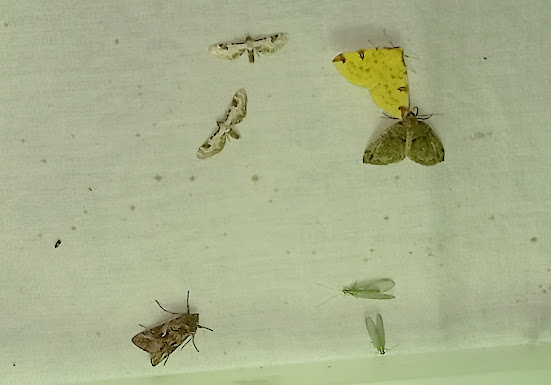Saturday 16th July 2022.
A cool start to the day with a bit of a breeze blowing too, though I know it's going to be another scorcher today. I have got a busy day ahead of me preparing for my wife’s Birthday BBQ and the patio needs a good scrub already, but first things first - the moth box! The local cats making a din nearby got a friendly water gun treatment and quickly scarpered; possibly the same Common Wasp from yesterday was giving me a bad time and so quickly got swatted (it survived and flew off) and the local House Sparrows soon came down to grab a moth or two, but not while I was still there!
Again, nowhere near the number of moths that I got earlier in the week, but with Sunday, Monday and possibly Tuesdays temperatures climbing into the 90’s plus, that could change? There were 92 moths of 37 species recorded this morning including another four new species for the year. Two Dark Spectacle’s were a good find and the delicate Least Carpet were both annual to my garden, but good additions to my year total. The very small micromoth Borkhausenia fuscescens identification was clinched using the Obsidentify App, which was most useful. No Beetles in the moth box this morning, but there were two Harlequin Ladybirds and several Lacewings as per usual.
Above, the tiny micro moth, Borkhausenia fuscescens and below, one of the immigrant moths, Rusty-dot Pearl. These are regular about this time of year and I wonder if we will get an invasion of this species due to the forthcoming high temperatures?
The moths present this morning include the folllowing:
- 2 Dark Spectacle (NFY)
- 1 Least Carpet (NFY)
- 2 Willow Beauty
- 2 Buff Ermine
- 2 White Ermine
- 4 Riband Wave
- 1 Garden Carpet
- 3 Lime-speck Pug
- 2 Double-striped Pug
- 1 Pale Mottled Willow
- 4 Bright-line Brown-eye
- 4 Brimstone Moth
- 1 Cabbage Moth
- 1 Common Footman
- 1 Dark Arches
- 1 Square-spot Rustic (NFY)
- 2 Borkjausenia fuscescens (NFY)
- 2 Eudonia mercurella
- 7 Endotricha flammealis
- 1 Bee Moth
- 1 Swammerdamia pyrella
- 1 Blastobasis lacticolella
- 3 Blastobasis adustella
- 2 Horse-chestnut Leaf Miner
- 8 Apple Leaf Miner
- 1 Oegoconia quadripuncta
- 11 Light Brown Apple Moth
- 1 Chrysoteuchia culmella
- 1 Udea fulvalis
- 9 Common Plume
- 2 Brown House Moth
- 3 Tachystola acroxantha
- 1 Mother-of-Pearl
- 1 White-shouldered House Moth
- 1 Rusty-dot Pearl
- 1 Rush Veneer
- 1 Bird-cherry Ermine
As mentioned before, I have a busy day ahead of me and so no birding with Andy this morning, but I shall keep an eye out in the garden for anything of note. The Lesser Yellowlegs were still present yesterday for its third day at Normandy Marshes, Lymington and Sandpipers are on the move it seems, with Common, Green and Wood Sandpipers all reported lately at various sites in Hampshire. The big rarities in the UK currently are the long staying Red-tailed Shrike and Black-browed Albatross at Bempton Cliffs and not too far away at Stanpit Marshes in Dorset, a superb Caspian Tern is gracing the harbour there; one of many in the UK at present. I wonder what else this hot weather will bring into the UK?











.jpg)



.jpg)


.JPG)
.JPG)
.JPG)
.JPG)















.JPG)
.JPG)
.JPG)
.JPG)
.JPG)
.JPG)
.JPG)



.JPG)
.JPG)
.JPG)
.JPG)
.JPG)
.JPG)




